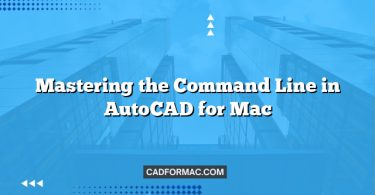AutoCAD for Mac offers powerful customization tools that allow users to tailor the interface to their specific workflows. One of the most effective ways to personalize your experience is by modifying the Customize User Interface (CUI). While the Mac version of AutoCAD has some differences compared to its Windows counterpart, it still provides robust options for customizing toolbars, menus, ribbons, and keyboard shortcuts.
This guide walks you through the process of customizing the CUI in AutoCAD for Mac, helping you streamline your design process and boost productivity.
What Is the CUI?
The Customize User Interface (CUI) is AutoCAD’s built-in editor for modifying interface elements such as:
- Menus and submenus
- Toolbars and panels
- Keyboard shortcuts (key combinations)
- Mouse button assignments
- Quick Access Toolbar (QAT)
- Ribbon tabs and panels
Customizing these elements can significantly reduce repetitive tasks and make frequently used commands more accessible.
Accessing the CUI Editor in AutoCAD for Mac
- Open AutoCAD for Mac.
- Go to the top menu bar and click Tools > Customize.
- Alternatively, you can type
CUIin the command line and press Enter.
- Alternatively, you can type
- The Customize dialog box will appear—this is your CUI editor.
Note: AutoCAD for Mac uses a simplified CUI interface compared to Windows. Some advanced features (like full ribbon customization) may be limited, but core customization options are fully supported.
Customizing Menus and Toolbars
Adding or Removing Menu Items
- In the Customize dialog, select the Menus tab.
- Expand the menu tree to view existing menus (e.g., File, Edit, View).
- To add a new command:
- Drag a command from the Commands list (on the right) into the desired menu location.
- To remove a menu item:
- Select the item in the menu tree and click the – (minus) button.
Creating a Custom Toolbar
- Switch to the Toolbars tab.
- Click the + button to create a new toolbar.
- Name your toolbar (e.g., “My Drafting Tools”).
- Drag commands from the Commands list onto your new toolbar.
- Click Done to save.
Tip: You can dock your custom toolbar by dragging it to the top or side of the drawing area.
Customizing Keyboard Shortcuts
Keyboard shortcuts are essential for efficient drafting. Here’s how to create or modify them:
- In the Customize dialog, go to the Keyboard Shortcuts tab.
- To assign a new shortcut:
- Click + under the Shortcuts list.
- Press the desired key combination (e.g., Cmd+Shift+L).
- Select a command from the Commands list to assign it.
- To edit an existing shortcut:
- Select it in the list and click the pencil icon.
- To remove a shortcut, select it and click –.
Warning: Avoid overriding essential system shortcuts (e.g., Cmd+Q for Quit) or AutoCAD defaults unless you’re certain.
Customizing the Quick Access Toolbar (QAT)
The QAT appears at the top-left of the AutoCAD window and provides one-click access to frequently used tools.
- Right-click any command in the Ribbon or menu.
- Choose Add to Quick Access Toolbar.
- To rearrange or remove QAT items:
- Right-click the QAT itself.
- Select Customize Quick Access Toolbar.
- Use the dialog to reorder or delete buttons.
Saving and Managing Your Customizations
AutoCAD for Mac automatically saves your CUI changes to your user profile. However, it’s wise to back up your custom workspace:
- Go to AutoCAD > Preferences > Profiles.
- Click Export to save your current profile (including CUI settings) as a
.argfile. - To restore or share your customizations, use Import on another Mac.
Best Practices for CUI Customization
- Start small: Add only the commands you use most often.
- Use consistent naming: Label custom toolbars and shortcuts clearly.
- Test thoroughly: Ensure new shortcuts don’t conflict with existing ones.
- Document changes: Keep a note of your customizations for future reference or team sharing.
Limitations to Keep in Mind
- AutoCAD for Mac does not support full ribbon tab customization like the Windows version.
- Some advanced CUI features (e.g., partial CUI loading, enterprise CUI deployment) are Windows-only.
- Always ensure you’re running the latest version of AutoCAD for Mac to access the most up-to-date customization options.
Frequently Asked Questions (FAQ)
1. Can I import a CUI file created on AutoCAD for Windows into AutoCAD for Mac?
No, you cannot directly import a .cui or .cuix file from AutoCAD for Windows into AutoCAD for Mac. The two platforms use different interface architectures, and CUI files are not cross-compatible. You’ll need to manually recreate your customizations using the Mac’s Customize dialog.
2. Where are my CUI customizations stored on macOS?
Your CUI settings are saved within your AutoCAD user profile. The actual files are stored in a hidden application support folder:
~/Library/Application Support/Autodesk/AutoCAD [Version]/R[Release]/[Language]/Support/
However, it’s recommended to back up your settings using Preferences > Profiles > Export rather than manually copying files.
3. Why don’t my custom toolbars appear after restarting AutoCAD?
Make sure your custom toolbar is enabled. Go to View > Toolbars and check if your toolbar name has a checkmark next to it. If not, click it to turn it on. Also, ensure you clicked Done (not just closed the window) in the Customize dialog to save your changes.
4. Can I create custom menus that appear in the top menu bar (like File or Edit)?
AutoCAD for Mac does not allow you to add new top-level menus (e.g., a “My Tools” menu next to “Window” or “Help”). However, you can add custom commands to existing menus or create floating toolbars that serve a similar purpose.
5. Is it possible to assign a keyboard shortcut to a LISP routine or script?
Yes! First, ensure your LISP routine or script is loaded (e.g., via AppLoad or Startup Suite). Then, in the Customize > Keyboard Shortcuts tab, find your custom command (it will appear by its command name, like MYCOMMAND) in the Commands list and assign a shortcut to it just like any built-in command.
6. How do I reset my CUI customizations to default?
To restore the default interface:
- Go to AutoCAD > Preferences > Profiles.
- Click Reset to Default.
This will revert all interface customizations, including toolbars, menus, and shortcuts, to their original state. Be sure to export your current profile first if you want to keep a backup.
7. Can I customize the right-click (context) menu in AutoCAD for Mac?
Limited customization of the right-click context menu is available. In the Customize dialog, go to the Mouse tab to adjust default actions for mouse buttons, but you cannot add or remove specific commands from the context menu like in the Windows version.
8. Do CUI customizations sync across multiple Macs if I use the same Autodesk account?
No. AutoCAD for Mac does not currently sync CUI settings or workspace preferences through your Autodesk account. You’ll need to manually export your profile (as a .arg file) and import it on another Mac to replicate your setup.
These FAQs address common pain points and advanced scenarios that Mac users often encounter when customizing their AutoCAD interface—helping you get the most out of your CUI setup without confusion.
Conclusion
Customizing the CUI in AutoCAD for Mac empowers you to create a more intuitive and efficient design environment. By tailoring menus, toolbars, and keyboard shortcuts to your unique workflow, you can reduce clicks, minimize errors, and focus more on your designs.
Take time to explore the Customize dialog—experiment with different layouts and shortcuts until your interface feels like a natural extension of your design process.
Pro Tip: Share your custom CUI settings with teammates to standardize workflows across your Mac-based design team!




